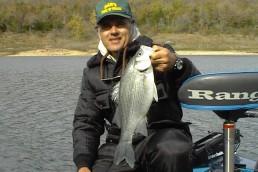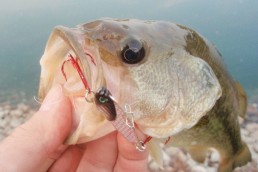Spring White Bass in the Ozarks
SHARE THIS POST
Each year as spring rolls around, my thoughts go off to thinking about fishing for white bass, especially in the Ozarks. This time of year, they start moving into shallow creek arms and along gravel/rock points. The fish are easily found, and ready to strike.
They can be caught with a small selection of lures and colors. My selection consists of Rat-L-Traps in Smoky Joe and Chrome/Black Back; Blitz Blades in Silver/Black Back and Natural Minnow; Natural Forage Baits 3.75” Swim Bait in Green Shad and Natural Shad on B-Fish-N H20 Precision jig heads; and Road Runners of all sizes, in white. The nice thing about this selection is that it also works well for any black bass species, as well as for big crappies that might be lurking around the same area. Even an occasional walleye and carp will hit. Yes, I said carp, which is another article in itself.
As you can see, the color selection is mainly something with flash and white. In other words, something similar to a baitfish in pattern and color works best. It has been rare for me to find any other type of color having a high success ratio.
When searching for the active fish, I like going all the way to the back of the creek arm and working the side to which the creek bed is hugging, but at all times looking for shad busts. A shad bust indicates where the fish are feeding at that moment, and in shallow water, when the feeding action stops, they have moved elsewhere. If a “bust” happens in deep water, and the action stops, then it is very possible that they have only moved a little deeper, but in the same general spot.
Watch for where you see schools of baitfish, which are easily seen in shallow-water areas. This is where the action may take place.
Parallel the shore and old creek bed with the lures, starting with a Rat-L-Trap or Blade. These are fast-moving search baits. When the action slows on these lures, switch to the Swim Bait and Road Runners. In fact, there has been many times that a white Pro Series Road Runner is all that I’ve needed all day for all species in that area.
Another spot to fish is in the middle of the shallow arm, which is often indicated by the previously mentioned shad bust. This is not always the case, but is often effective if action has slowed a bit along the shore with the creek hugging to it, as the middle is actually the opposite shore of the old bed.
Are you enjoying this post?
You can be among the first to get the latest info on where to go, what to use and how to use it!
Next, move to the other side of the creek. Often, I’ve stayed the whole time in the back of one arm, just moving back and forth; or if another creek is close by, I’ll start the big engine and fly back over to that area. A perfect example is in Bull Shoals Lake, where Big Sister Creek has three arms, and Jimmie Creek has Mitchell Creek close by, separated by a shallow gravel point, which has been a great location.
While on the subject of the gravel point, this is where I move next from the backs of the creeks. These points can go way out, and will many times hold large numbers of actively feeding fish. In fact, gravel points, especially those with wind blowing over them, have produced a few walleyes mixed in with the white bass, and they will normally hit on the Blades and Swim Baits.
Creek arms also have bluffs that are normally in the deeper main areas, but sometimes are in the shallower end. In many cases, this is where the main creek bed is running. I never pass up such an area, as some of my largest white bass have been found there. With this area, I’ll have my best fishing paralleling the shore, and running the lures at all different depths until that “magic zone” is found. I’ll also use a pump/lift-and-fall retriev,e rather than a straight, constant retrieve that is used in the backs of the creeks and across shallow points.
As previously mentioned, remember that no matter what area is being fished, keep an eye open for schools of baitfish and shad busts. Large concentrations of feeding gulls are also an indicator of feeding fish that are chasing bait to the surface, along with having a few crippled ones floating up.
The aforementioned tactics and tackle will work wherever you have this species of fish, but as everyone knows through the years, my favorite lake for white bass has been Bull Shoals. I’ve fished out of the Bull Shoals Lake Boat Dock on the Arkansas side, where there is easy access, and short trips to some of the best creeks holding this species of fish. That includes Jimmie, Mitchell, Little Sisters, Big Sisters, Gunnel Fork and Noe Creeks. I’ve caught whites in all of these areas, and have had more time fishing than traveling long distances.
Wherever you live, and want some great spring fishing action, search out “spring whites” for a fun trip.
For more information…
If you are interested in taking a trip to the area, check out the conditions and reports, or download a brochure from Rick Eastwold: bullshoalslakeboatdock.com; on facebook.com/bullshoalslakeboatdock or call (870) 445-4424. This is a full service marina, which also has boat and houseboat rentals, and the Lighthouse Resort.
MWO
SHARE THIS POST
Did you enjoy this post?
You can be among the first to get the latest info on where to go, what to use and how to use it!
Dan Galusha
Dan Galusha has fished all of his life, worked more than 45 years in the outdoor/media industry, and was inducted into the Fresh Water Fishing Hall of Fame as a Legendary Communicator. Direct questions through dansfishntales.com, facebook.com/dansfishntales and facebook.com/shootnplink.



